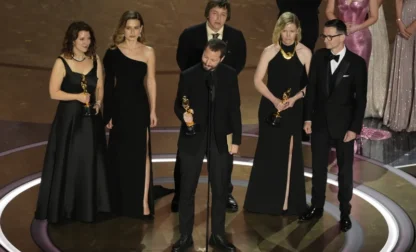WASHINGTON (AP) — Jacquelyn Martin is a staff photojournalist with The Associated Press based in Washington. She covers politics at the White House and Congress and has traveled the world as a pool photographer covering every secretary of state since Hillary Clinton. She is also known for her self-driven enterprise feature packages for which she photographs, writes and records video. She was the last press photographer to photograph Nelson Mandela before he died.

—-
This feature is part of a series highlighting Associated Press journalists for Women’s History Month. An earlier installment featured one of our photographers working in Ghana and her work focusing on the lives of women in her country.
—-
Based in Washington for the AP, I cover a lot of high-stakes politics. I’m used to working in scrums, walking the fine line between being assertive while also using finesse to ensure access. Too aggressive and no one wants to work with you. Too soft and you’ll get run over. When I started in 2006, female photojournalists in Washington were greatly outnumbered by men. While trailblazing colleagues like AP’s Susan Walsh pushed boundaries long before I arrived, and more women have joined us in the years since, there were many years where I was the only female face in the photo scrums. It taught me a lot about walking that line, which was useful this past October.
On Oct. 11, 2023, I boarded a U.S. Air Force plane to fly with Secretary of State Antony Blinken on his last-minute trip to Israel and the Middle East in an attempt to stop all-out war from spreading across the region in the wake of the Oct. 7 attack by Hamas against Israel. I was assigned as the photo pooler and tasked with providing pictures to U.S. news outlets and the global wires with pictures of these frantic diplomatic efforts.
With one day’s notice and no idea of how long we might be away, I packed lightly and prepped what captions I could, knowing everything could change at a moment’s notice. Although I’ve covered the State Department, traveling as the photo pooler many times, under several administrations, I knew this story was urgent and that gave me a renewed sense of purpose.
The Middle East can be a tough place to photograph under the best of circumstances. Access can be difficult, the press and officials can be intense, and you must be quite assertive. It’s also less common to see female photojournalists there. Sometimes people not knowing what to make of you works in your favor. Add in volatile international politics, a brewing war and sky-high tensions, and that made it even more challenging. The assignment took on a greater sense of urgency, knowing that people’s lives would be affected by the meetings I was covering. The adrenaline made it hard to sleep, but that was a good thing because it turned out we wouldn’t be sleeping much. I knew my colleagues in the region were out in the field and in danger. Still, I had to do my best to document this one part of the larger story.
Right away I could sense the chaos, and thus an opportunity, to make more behind-the-scenes imagery than is usually possible. Being prepared and working the chaos to your advantage can lead to more storytelling moments. These photo sprays are often highly orchestrated. This time there was so much up in the air that I was able to quickly calculate where to position myself, slip in, do my job, and come away with more of a variety of scenes than normal. It helped that I’ve worked with the State Department team before; in fact, I was with them as the pooler for a trip to the Middle East just months before. You must show that you can do the work, that you won’t get in the way. It helps to show them that if they work with you and trust your instincts, that images of their guy will go around the world.
I need to travel lightly on State Department trips. I wear all the gear on my body, even on the planes. There’s no time to pack and unpack a camera bag. Traveling compactly comes in handy when you must push through a wall of Qatari official photographers or slip into photo opportunities quickly last minute because you had to sprint up from the back of a very long motorcade.
I’m not a photographer who covers war and conflict. I cover mainly politics. There was one overnight moment when we were being held outside in the middle of Israel’s Ministry of Defense in Tel Aviv where alarms went off. Rockets were incoming and the press pool had to seek shelter underground. I felt the booms from the Iron Dome detonation. I hadn’t experienced that previously, and it shook me. As a mother, I will admit to sending messages to my son to say I loved him, just in case. It seems sort of silly looking back, as we were in a safe place and so many people in the region were suffering much worse at that same moment. But it was scary and really brought home the seriousness of what had happened and how the situation could spiral.
Staff Photojournalist




